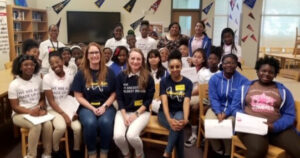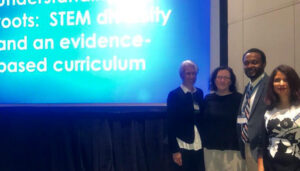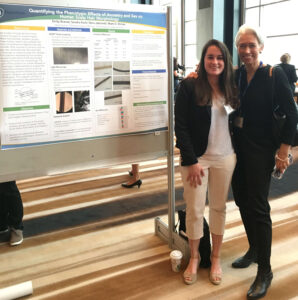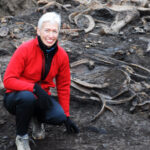Nina Jablonski and Barney Pityana write for The Conversation – Why does racism prevail?
“All people belong to one biological species and there are no human “races”. So why does belief in race persist? It may be a scientific misconception, but it is real. It defines the lived experience of many people and determines how governments act and how people treat one another. How did race come to have this power and this durability?
A project was undertaken to address these very questions and to get at the heart of the “everydayness” of race in South Africa and elsewhere. Called the Effects of Race Project, it was started at the Stellenbosch Institute for Advanced Study in South Africa in 2013 as part of a broader project at the institute called Being Human Today.”
Finding Your Roots selected for NSF STEM for All Multiplex event
The Finding Your Roots Genetics & Genealogy Curriculum, shown in action in the season 5 finale of Finding Your Roots with Henry Louis Gates Jr., will be featured in the new National Science Foundation STEM for All Multiplex web site’s inaugural event with a live expert panel Monday Jan. 13th at 1:30ET. The online panel will discuss how to broaden participation in STEM through community engagement and will include “Finding Your Roots” camp instructor and evolutionary biologist C. Brandon Ogbunu.
The NSF STEM for All Multiplex is a new, interactive video platform which enables researchers, educators and parents access to federally funded, innovative programs aimed at improving STEM teaching and learning. Learn about exciting new approaches to STEM learning and join the conversation!
Finding Your Roots: The Seedlings Wins Mid-Atlantic Emmy
In the award-winning episode, “Finding Your Roots: The Seedlings – Classification,” campers participated in a surprising activity to get them ready for a trip to the Matson Museum of Anthropology at Penn State. Graduate students and mentors showed campers how to find clues in skulls and bones to determine sex, species and evolutionary order.
The WPSU crew included Kristian Berg (producer/director), Cheraine Stanford (producer) and Tyler Henderson (editor).
The “Finding Your Roots: The Seedlings” web series follows 13 young people using science and research skills at a genetics and genealogy camp to answer the question “Who am I?” With an innovative curriculum envisioned by Henry Louis Gates, Jr., host of the popular PBS series “Finding Your Roots” and developed by a team led by Penn State professor Nina Jablonski from the College of the Liberal Arts, campers explore their own family history and DNA ancestry with techniques never before used in an educational setting.
Nina Jablonski talks about skin pigmentation and the skin microbiome in the exhibit “Dans Ma Peau” at the Musée de l’Homme, now running in Paris.
Skin Pigmentation as a Sign of Evolution
Skin is universal. Whether it’s light or dark, young or old, its structure is the same from one individual to another… except for two details: its pigmentation and the bacteria that protects it.
This is what researcher Nina Jablonski, a specialist in anthropology and paleobiology, explained during the exhibit “Dans Ma Peau” at the Musée de l’Homme, in Paris: “By observing the map of solar radiation, we can see how skin color evolved according to sunlight. It’s both a compromise and a great evolutionary story.”
In My Skin: The skin, another history of mankind #4
To mark the fifth anniversary of L’Oréal R&I’s Scientific Advisory Board (SAB), an exceptional event was organized at the Musée de l’Homme in Paris. For this special occasion, two eminent SAB members, Nina Jablonski and Bonnie Bassler, kindly agreed to star in our miniseries. The two experts enthusiastically shared their knowledge in biology and anthropology, shining a new light on topics such as pigmentation or the microbiome.
 “More than 60 years after scientists made crucial discoveries about the structure of DNA, 20 students at Coretta Scott King Young Women’s Leadership Academy gained insight into some of the molecular mysteries that make them who they are. Last fall, while studying life sciences, the girls swabbed their cheeks and sent samples off to Living DNA, a U.K.-based consumer DNA testing company. The big reveal of the test results this week left a big impression on the seventh graders, who were able to make real-world connections to topics they have been studying all semester long including colorism, bigotry and genotypes.” (article by Nedra Rhone, The Atlanta Journal-Constitution)
“More than 60 years after scientists made crucial discoveries about the structure of DNA, 20 students at Coretta Scott King Young Women’s Leadership Academy gained insight into some of the molecular mysteries that make them who they are. Last fall, while studying life sciences, the girls swabbed their cheeks and sent samples off to Living DNA, a U.K.-based consumer DNA testing company. The big reveal of the test results this week left a big impression on the seventh graders, who were able to make real-world connections to topics they have been studying all semester long including colorism, bigotry and genotypes.” (article by Nedra Rhone, The Atlanta Journal-Constitution)
Don’t Skip the Sunscreen
Dermatologists told us all to avoid sun exposure. Now we know a lack of sun puts darker-skinned people at greater risk for hypertension.
“There’s likely to be a sweet spot for sun exposure, Jablonski said, which would balance out the risks and benefits. That spot will be different for darker-skinned people than for those with medium skin tones, and different still for the very fair. And yes, she said, a need for more sunlight might at least partly account for the fact that African Americans suffer disproportionately from hypertension.”
Read more at How Good Advice on Skin Cancer Can Be Bad for Your Blood Pressure, Bloomberg Opinion, February 4, 2019 by Faye Flam.
Practical and Ethical Considerations of Using Personal DNA Tests with Middle-School-Aged Learners
Personalized genetic information is not widely utilized as a resource in learning environments, in part because of concerns about data privacy and the treatment of sensitive personal information. Here we describe the implementation of a curriculum centered on analyzing personalized genetic-ancestry test results during two-week science summer camps for middle-school-aged youth. Our research focused on how the examination of personalized DNA results affected learners’ subsequent perceptions and performance, as measured by in-camp pre- and post-tests and surveys, analysis of voluntary student talk captured by audio and video recordings, and periodic one-on-one post-camp follow-ups. The curriculum was grounded in Next Generation Science Standards (NGSS) and focused around the central question of “Who am I?” Campers approached this question via guided lessons designed to shed light on their genetic uniqueness, the many attributes of their genotype and phenotype shared with others, their more distant genetic and evolutionary ancestries, and their roles as active agents in the healthy continuation of their lives. Data relevant to these questions came from edited subsets of ancestry-informative single-nucleotide polymorphisms (SNPs) and phenotype-related SNPs from the campers’ genotype results, which their parents had received from a direct-to-consumer vendor. Our approaches to data privacy and the discovery, disclosure, and discussion of sensitive information on paternity, carrier status, and ancestry can be usefully applied and modified for many educational contexts. On the basis of our pilot implementations, we recommend additional and expanded research on how to incorporate personalized genetic ancestry information in a variety of learning contexts.
AJHG Speaks to Elizabeth Wright about the Finding Your Roots project
Shades of complexity: New perspectives on the evolution and genetic architecture of human skin
Like many highly variable human traits, more than a dozen genes are known to contribute to the full range of skin color. However, the historical bias in favor of genetic studies in European and European‐derived populations has blinded us to the magnitude of pigmentation’s complexity. As deliberate efforts are being made to better characterize diverse global populations and new sequencing technologies, better measurement tools, functional assessments, predictive modeling, and ancient DNA analyses become more widely accessible, we are beginning to appreciate how limited our understanding of the genetic bases of human skin color have been. Novel variants in genes not previously linked to pigmentation have been identified and evidence is mounting that there are hundreds more variants yet to be found. Even for genes that have been exhaustively characterized in European populations like MC1R, OCA2, and SLC24A5, research in previously understudied groups is leading to a new appreciation of the degree to which genetic diversity, epistatic interactions, pleiotropy, admixture, global and local adaptation, and cultural practices operate in population‐specific ways to shape the genetic architecture of skin color. Furthermore, we are coming to terms with how factors like tanning response and barrier function may also have influenced selection on skin throughout human history. By examining how our knowledge of pigmentation genetics has shifted in the last decade, we can better appreciate how far we have come in understanding human diversity and the still long road ahead for understanding many complex human traits.
Variation in human hair ultrastructure among three biogeographic populations
Human scalp hairs are often examined microscopically to study the variation and diversity among a range of visible morphological traits. In this study, we focused on the ultrastructure of human scalp hair within its keratinized matrix, emphasizing, the density and distribution of melanosomes, variation in cuticle thickness within populations, and the relationship of hair fiber ultrastructure with biogeographic ancestry. We used transmission electron microscopy (TEM) to visualize hair cross-sections and generate micron-scale resolution images for analysis of particle morphology and the layered hair matrix. Our results revealed considerable variation in all parameters examined, including the relationship of ultrastructure to biogeographic ancestry. Among the three metapopulations studied (European, African, and East Asian), we identified hair cross-sectional shape, cuticle dimensions, and melanosome distribution as traits that reveal statistically significant ancestry-related patterns. This study establishes trait patterns in hair morphology and ultrastructure among three biogeographically defined metapopulations to improve the current understanding of human variation in hair form and establish a foundation for future studies on the genetic and developmental bases of phenotypic variation in hair ultrastructure related to genotype.
 A new middle school genetics and genealogy curriculum developed in part by Penn State will be featured during an online showcase that highlights innovation and STEM education.
A new middle school genetics and genealogy curriculum developed in part by Penn State will be featured during an online showcase that highlights innovation and STEM education.
The 2018 STEM for All Video Showcase, funded by the National Science Foundation, will be held online at stemforall2018.videohall.com from May 14 to 21. Researchers from Penn State’s College of the Liberal Arts helped develop the curriculum “The Finding Your Roots Genetics & Genealogy Curriculum.” WPSU Penn State produced the video that will be featured in the showcase.
 One of South Africa’s literary stalwarts, Sindiwe Magona, has teamed up with well-renowned American anthropologist, Nina G. Jablonski, to create Skin we are in, a much-needed book about race and skin colour – for children. Together with award-winning illustrator Lynn Fellman, the trio have researched, written and produced a lively and colourful book to educate children on the science behind skin colour.
One of South Africa’s literary stalwarts, Sindiwe Magona, has teamed up with well-renowned American anthropologist, Nina G. Jablonski, to create Skin we are in, a much-needed book about race and skin colour – for children. Together with award-winning illustrator Lynn Fellman, the trio have researched, written and produced a lively and colourful book to educate children on the science behind skin colour.
 Focusing science education on students through genetic and genealogical studies may be the way to increase minorities in the pipeline and engage students who would otherwise deem science too hard or too uninteresting, according to a Penn State anthropologist.
Focusing science education on students through genetic and genealogical studies may be the way to increase minorities in the pipeline and engage students who would otherwise deem science too hard or too uninteresting, according to a Penn State anthropologist.
“Henry Louis Gates (Jr.) and I talked about using personalized genetics and genealogy in classrooms as a way to help get kids to understand their heritage and be proud,” said Nina Jablonski, Evan Pugh University Professor of Anthropology, Penn State. “And especially for African-American kids to connect with their heritage. Then also, equally, as a way to create interest in science.”
 Nina Jablonski hosted a symposium titled “Understanding Your Roots: STEM Diversity and an Evidence-Based Curriculum” at the 2018 AAAS Annual Meeting in Austin, TX on February 17, 2018. Biz Wright (Penn State) and Brandon Ogbunu (Brown Univ.) presented preliminary research and teaching methodologies from the Penn State led Finding Your Roots summer camps, while Aditi Pai (Spelman College) shared details about an undergraduate level genetics and genealogy course. Please see Penn State News for more details.
Nina Jablonski hosted a symposium titled “Understanding Your Roots: STEM Diversity and an Evidence-Based Curriculum” at the 2018 AAAS Annual Meeting in Austin, TX on February 17, 2018. Biz Wright (Penn State) and Brandon Ogbunu (Brown Univ.) presented preliminary research and teaching methodologies from the Penn State led Finding Your Roots summer camps, while Aditi Pai (Spelman College) shared details about an undergraduate level genetics and genealogy course. Please see Penn State News for more details.
Thermoregulatory Properties of Hair: Is Human Hair Morphology Adaptive?
 Finding Your Roots: The Seedlings web-series by WPSU premiered this fall. Full episodes and related curriculum are available at www.fyrclassroom.org.
Finding Your Roots: The Seedlings web-series by WPSU premiered this fall. Full episodes and related curriculum are available at www.fyrclassroom.org.
Can two weeks of summer camp have a lasting impact on how students feel about science? Researchers at Penn State are trying to find out by using genealogy research to get kids interested in science and increase diversity in STEM fields. In this edition of Digging Deeper Penn State president Eric Barron explores the impact of the Finding Your Roots summer camp.
Nina Jablonski’s 2017 Charles M. and Martha Hitchcock Lectures
Nina Jablonski’s 2017 Charles M. and Martha Hitchcock Lectures at UC Berkeley are now available (audio and video):
The Real ‘Skin in the Game’: The History of Naked, Sweaty, and Colorful Skin in the Human Lineage
The Cost of Color: The Health and Social Consequences of Skin Color for People Today
Dr. Xiaoming Wang, Curator and Head of Vertebrate Palaeontology at the Natural History Museum of Los Angeles County and Dr. Denise Su, Curator & Head of Paleobotany and Paleoecology at the Cleveland Museum of Natural History have published a paper with colleagues (including Nina G. Jablonski) in the Journal of Systematic Paleontology on the discovery of one of the largest otter species ever found. This discovery was made in the Yunnan Province, Southwestern China by an international team of scientists from the United States, France, and China. It represents groundbreaking research into the evolution of a little-known fossil genus of the otter family. (Art by Mauricio Antón)
 The first Finding Your Roots summer camp wrapped up on July 1 2016 at two locations – Penn State University and University of South Carolina. Kids between 11-13 years old spent two weeks learning about their genetic ancestry, genealogy, and how to use that data to make healthy choices.
The first Finding Your Roots summer camp wrapped up on July 1 2016 at two locations – Penn State University and University of South Carolina. Kids between 11-13 years old spent two weeks learning about their genetic ancestry, genealogy, and how to use that data to make healthy choices.
Hsin-Yu Chen, Ph.D. candidate, 2016-17 recipient of the Kligman Graduate Fellowship
Hsin-Yu Chen, Ph.D. candidate in Recreation, Parks, and Tourism Management, has been notified that she is the 2016-17 recipient of the Kligman Graduate Fellowship in the College of Health and Human Development. This one-year fellowship is designed to support graduate students exhibiting excellence, and permits the awardee to focus exclusively on their own research and education.
Emily Bramel awarded third place in the Health and Life Sciences category of the 2016 Undergraduate Exhibition Award
 Emily Bramel, a Schreyer Honors College undergraduate conducting research in the Jablonski Lab, was awarded third place in the Health and Life Sciences category of the 2016 Undergraduate Exhibition Award competition for the poster presentation of her research project, “Quantifying Phenotypic Differences in Human Scalp Hair Morphology Associated with Ancestry and Sex”
Emily Bramel, a Schreyer Honors College undergraduate conducting research in the Jablonski Lab, was awarded third place in the Health and Life Sciences category of the 2016 Undergraduate Exhibition Award competition for the poster presentation of her research project, “Quantifying Phenotypic Differences in Human Scalp Hair Morphology Associated with Ancestry and Sex”

